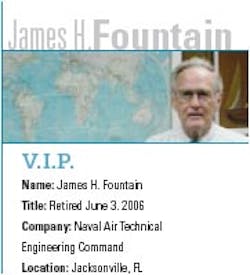VIP - In the Navy
Q: How is the ground support industry unique in the Navy?
A: Support equipment (SE) divisions, ashore and afloat, are divisions of the aircraft intermediate maintenance departments assigned eight to 75 SE personnel, depending on the size of the operation. They perform the SE maintenance on 10 to 700 pieces of support equipment. I became the SE tech rep at the Naval Air Station (NAS) in Jacksonville in August 1967 and held the position for 38 years. I went temporary duty to various naval activities worldwide, providing SE technical assistance in support equipment.
Q: How did you get into aviation? Naval Support?
A: I joined the Navy May 18, 1948, attended basic boot camp in San Diego, [had] eight weeks of technical training in Memphis and then went on to a 23-week aviation electrical school in Memphis. In 1955, was assigned as a student in the Navy's advanced "B" electrical school, 33 weeks in Jacksonville FL. In 1957, I was advanced to chief, providing aircraft electrical maintenance and instruction on various aircraft. I retired in San Diego with 20 years of service in 1967 and returned to Jacksonville, Fla. looking for a job. I went to NAESU headquarters in Philadelphia and was hired as an SE tech rep assigned to NAS Jacksonville in August 1967 (NAESU became NATEC in 1998).
Q: You recently spearheaded a battery conditioner/charger project from initial testing through Navy approval - how did the process work?
A: The Naval Air Engineering Warfare Center (NAWC) Lakehurst had been reporting for sometime that the SE batteries were the biggest problem in the naval aviation support equipment arena. Around 1996 they changed the SE flooded batteries to the sealed Optima batteries in all naval support equipment. The Optima batteries started developing a "no re-charge" status in three to six months and dead batteries were piling up on pallets marked for disposal in many activities.
In the fall of 2001 I got permission from the Navy safety and fire departments to establish a prototype Optima Battery Charging Station in the NAS Jacksonville "SE work spaces."
Q: What are the benefits of new battery charging and testing systems?
A: NAS Jacksonville is five years into the program and reporting cost avoidance of approximately $12 thousand per year. In 2004 we went aboard the USS Eisenhower and prototyped the Optima Charging Station for them.
They are reporting great success with the new charging process.
Q: What are some of the major trends you have seen developing over the past 20-30 years?
A: In 1967 we overhauled engines at the local level. Now, we do a quick engine change. The electrical black boxes we repaired at the local level are now throwaways [that] last much longer. The quality and reliability of support equipment has much improved through the years.
Q:If not in ground support, where would you be?
A: For 20 years I was an aviation electrician in the U.S. Nnavy. It took me 12 months to start liking ground support equipment. I was promoted to a GS-12 in 1969 and went on to complete 38 years as a civil servant. I thoroughly enjoyed ground support equipment [and] never wanted to work on an airplane again.
Q: How hard was it to step away from the Navy?
A: Not hard at all, just walked away into retirement. I'm very happy being retired, but would do a little part time work with ground support equipment.
Q: What golden nuggets of wisdom would you like to pass on to our readers?
A: The U.S. Navy is a great employer, and after 58 years, I would highly recommend it to anyone. Work hard and stay happy!
